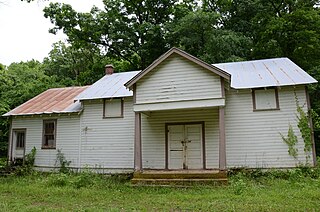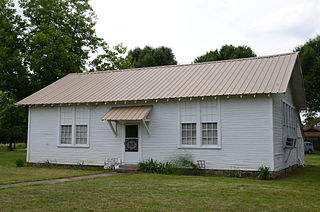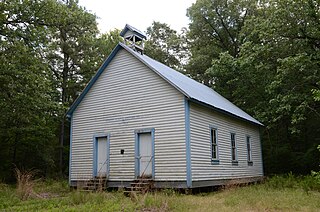
The Jumbo Church of Christ is a historic church in rural Izard County, Arkansas, west of the city of Melbourne. It is located on the Jumbo Road, about 4 miles (6.4 km) west of its junction with Arkansas Highway 9. It is a vernacular Plain Traditional wood frame structure, built on sandstone piers and topped with a gabled corrugated metal roof. The church was built c. 1927-28 by the citizens of the then-thriving community of Jumbo, and is one of its few surviving structures. The community's decline began after 1949, when its municipal services were consolidated with those of Melbourne, and people began moving to the larger community. The church was abandoned in 1984, but restored in 1997 by a group of former residents of the area.

The First Presbyterian Church is a historic church building at 212 College Avenue in Clarksville, Arkansas. It is a two-story steel-framed structure, finished in brick. It is rectangular, with a central sanctuary flanked on the sides by office and meeting spaces. At the center of its roof is a dome, which is obscured by gabled parapets on the street-facing facades. The church was designed by Rogers based architect A.O. Clarke, and was completed in 1922 for a congregation founded in 1840. It is the finest example of Classical Revival architecture in Johnson County.

The Oark School—Methodist Church is a historic church at the junction of Arkansas Highway 215 and County Road 34 in Oark, Arkansas. It is a rectangular single-story wood frame structure, with a gabled roof, novelty siding, and a fieldstone foundation. The gable ends of the roof are adorned with large knee brackets. Originally built c. 1923 as a collaboration between the local Methodist congregation and the school district, it served as both a public school and Methodist academy, the latter for a single season. It was used as a public school until 1938, when the district was consolidated with other area districts. It was briefly used as a school again in the 1950s, after the existing school burned down. It is now used as a community meeting hall.

The Bruno School Building was a historic school building a short way south of Arkansas Highway 9 in Bruno, Arkansas. It was a single story Plain Traditional (vernacular) frame structure, with a gable roof and a front porch with gabled pediment. Built in 1920, it had some Craftsman style influence, including exposed rafter tails and the square columns on stone piers which supported the porch. It was a locally significant well-preserved example of a rural school building.

The Cottonwood School No. 45 is a historic school building, now converted to a residence, in rural Boone County, Arkansas. It is located on Dubuque Road, northeast of the hamlet of Self. It is a single-story Craftsman style structure, finished in rubblestone veneer on a concrete foundation. A gabled porch extends across the central portion of the main facade, supported by three tapered posts on stone piers. The main roof is a gable-on-hip form. The school was built in 1926, and served the local community as a school and meeting place until 1945. It was converted to residential use in 1948, and underwent major rehabilitation in the 1980s.

The Fairview School Building is a historic school building in rural Marion County, Arkansas. It is located on the north side of County Road 8064, just west of its junction with Arkansas Highway 178 and the Fairview fire department. It is a single-story stone structure with a gabled tin roof whose eaves have exposed rafter tails in the Craftsman style. Its walls are of both cut and uncut fieldstone, and the foundation is also stone. The main (south-facing) facade is symmetrical, with sash windows flanking a raised double door. The school was built in 1927 by local volunteer labor, despite a downturn in the area's population and economy.

The Hulsey Bend School is a historic school building in rural southeastern Independence County, Arkansas. It is located east of Oil Trough on Freeze Bend Road, about 0.7 miles (1.1 km) north of Arkansas Highway 14. It is a single-story wood frame structure, with a gable roof and weatherboard siding. The gabled ends each have an entrance, while the sides each have three windows. Built c. 1900, it is the best-preserved district schoolhouse in the Oil Trough area and believed to be the last in the county; it was used as a school until 1947.

The Enterprise School is a historic school building in rural central-western Madison County, Arkansas. It is located at the junction of County Roads 6041 and 192. It is a single-story wood frame structure, basically rectangular in shape, with a metal roof, weatherboard siding, and a concrete foundation. Its roof has exposed rafter ends in the Craftsman style, and it has a double-door entry sheltered by a gabled porch supported by sloping posts. Built about 1935, its construction was probably funded by a Depression-era jobs program.

The Hopewell District No. 45 School was a historic former school building in rural White County, Arkansas. It was located northwest of Bald Knob on Arkansas Highway 258, at the southwest corner of Horton Road. It was a single-story stone structure, rectangular in shape, with a gable-on-hip roof that had a wide overhang and exposed rafters in the Craftsman style. Its front (eastern) facade had a gabled porch above the entrance at its center. It was built in the late 1930s with funding support from the Works Progress Administration. The building now houses a church, with a modern ell extending to the north.

The Liberty School Cafeteria is a historic school building in rural Faulkner County, Arkansas. It is located on the west side of Arkansas Highway 36, about 0.25 miles (0.40 km) north of its junction with United States Route 64, about midway between Conway and Vilonia. It is a modest single-story wood frame structure, with a gabled roof that has exposed rafter ends in the American craftsman style. It was built in 1935 with funding support from the Works Progress Administration, and originally housed classrooms for science, agriculture and math, as part of a consolidated regional primary school. In the 1940s it was converted into a cafeteria. The school district was further consolidated with Vilonia in the 1950s and 1960s, when this building's school function ceased. The grounds are now used for a flea market.

The Hawks Schoolhouse is a historic school building in rural western Perry County, Arkansas. It is located on the south side of County Road 7, in the easternmost section of Ouachita National Forest, near the hamlet of Ava. It is a single-story wood frame structure, with a gabled roof and weatherboard siding. The roof is capped by a small gable-roofed open belfry. The front facade has a pair of symmetrically placed entrances with simple molding. It was built in 1911, and is a well-preserved example of a district schoolhouse in a rural context.

The Union Church and School is a historic combination church and school in rural Logan County, Arkansas. It is located northeast of Paris, on the south side of Union Road at its junction with Clayton Lane. It is a vernacular single-story L-shaped wood frame structure, with a gabled roof, weatherboard siding, and a stone foundation. The right side of the building, a cross-gable section, was built about 1895, and the left portion was built about 1922. It served the surrounding community as a two-room school until 1948, and as a Presbyterian church until 1958.

The New Liberty School is a historic school building in rural Logan County, Arkansas. It is located east of New Blaine, on the south side of Arkansas Highway 22 east of the New Liberty Church. It is a single-story masonry structure, built of coursed stone and covered by a metal hip roof. Its front entrance is sheltered by a gabled portico supported by simple square posts set on brick piers. It was built in 1922, and is a well-preserved example of an early 20th-century school, built before Arkansas instituted significant reforms in school building standards.

The Ozone School is a historic school building at 14137 Arkansas Highway 21 in Ozone, Arkansas. It is a single-story masonry structure, built out of coursed fieldstone blocks and covered by gable-on-hip roof with exposed rafter ends. Its front entrance is sheltered by a distinctive projecting tower, with arched openings at the base and a transverse gabled roof above. The school was built in 1942 with funding from the Works Progress Administration, and was used as a public school until 1957, when the local district was consolidated with that of Lamar. The building was listed on the National Register of Historic Places in 2015.

The St. Paul Lutheran School, also known as the Lutherville School, is a historic school building in rural Johnson County, Arkansas. It is located on the east side of County Road 418, northeast of Lamar. It is a vernacular single-story wood-frame structure, with a gabled roof, weatherboard siding, and a fieldstone foundation. It was built in 1904, and is one of the only surviving remnants of an early 20th-century German Lutheran immigrant community.

The Liberty Schoolhouse, also known as the Mt. Grove School, is a historic schoolhouse in a remote part of Ozark-St. Francis National Forest in Logan County, Arkansas. It is east of Corley, Arkansas, near the junction of Valentine Spring and Copper Spring Roads. It is a single-story vernacular wood-frame structure, with a gabled roof, weatherboard siding, and a foundation of concrete block piers. It was built in 1897, and was used by the community as both a school and church. It served as a school until 1944, and also hosted civic meetings and social events.

The Tankersley-Stewart House was a historic house in rural Johnson County, Arkansas. Located north of Arkansas Highway 352, between Hunt and Clarksville, it was a single-story vernacular wood frame structure and a gabled roof. A single-story porch extended across its front, supported by square posts. Its only significant styling was an interior fireplace mantel with Greek Revival features. It was built about 1895 by Dr. Oliver Tankersley.

The Oak Hill School House is a historic school building at 151 Little Oak Hill Road in rural Searcy County, Arkansas, southwest of Marshall, Arkansas. It is a single-story stone structure, with a stone foundation, and a gabled roof maode of corrugated metal. A gabled porch shelters the main entrance at the center of the north facade, supported by square posts. The school was built about 1934 on the site of a wood-frame school built in 1910, and served the area community until the mid-1950s. It continues to serve the area community as a gathering place for social events and religious services.

The Yadkin Church is a historic church building on Upper James Creek Road in rural Randolph County, Arkansas, north of Ravenden Springs. Built about 1894, it is a single-story wood frame structure, with a gabled roof and clapboarded exterior. The main entrance is on the otherwise unadorned northeast face, and consists of a pair of paneled doors. Sash windows line the side walls, with one on the rear wall. It is the only significant surviving element of the town of Yadkin, which was a thriving farm community in the early 20th century. It was last used for regular services about 1950.

The Mount Salem Church and School is a historic building at 553 Mt. Salem Rd. #101 in rural Logan County, Arkansas, about 15 miles (24 km) southwest of Paris. It is a single-story wood frame structure, with a gabled roof and clapboarded exterior. Along with the adjacent cemetery, it is the only major surviving element of the Mount Salem community, which flourished in the late 19th and early 20th centuries. This building was constructed by the community in 1909–10, and was the third building on the site. All of them served as both a church and local school.















